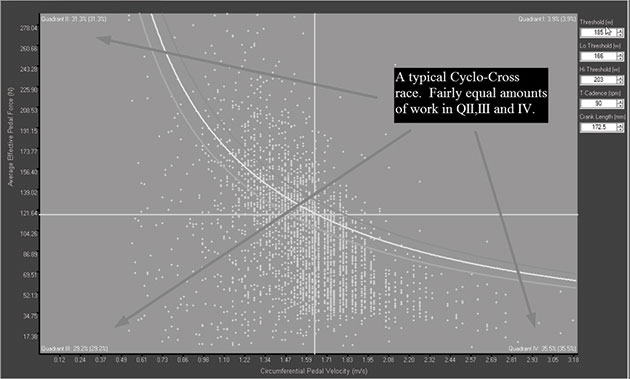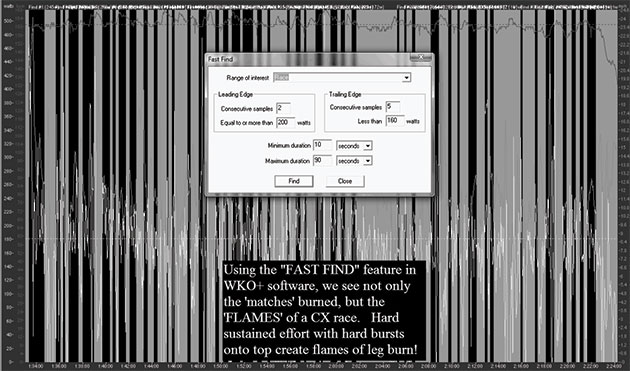

Cyclo-cross Racing & Training with a Power Meter
By PCG Founder & Coach Hunter Allen
Back to list of our training, coaching and nutrition essays

Les Woodland's book Paris-Roubaix: The Inside Story - All the bumps of cycling's cobbled classic is available as an audiobook here.
Using your power meter in Cyclo-Cross is not only effective but arguably one of your best weapons in pushing yourself to the next level. Cyclo-Cross brings its own set of demands in that you must be able to create quick bursts of effort over small obstacles, leap off the bicycle and run while carrying it for sections as long as thirty seconds and all the while maintain a pace at your Functional Threshold Power (FTP)and above for 40 minutes to 75 minutes.
So, it is nearly impossible to hold a steady power or even look at your power meter during a race or hard training session, but you can use your power meter to learn quite a few things about the demands of CX and at the same time tailor your training so that you can be ready for the next race. Power meter files from CX races typically average about 20-40 watts below what the actual FTP of the athlete is, since there is so much ‘down time’ when the athlete is either coasting down a technical hill or off the bike and running and the lack of traction on many of the courses.
The ability to put the power to the ground skews the power down and one has to take this into consideration when reviewing CX power files. Because of these running and technical coasting sections, it’s hard to determine the exact muscular demands of CX and when viewed in a Quadrant Analysis plot, a CX race contains the largest amount of amount of the effort in QII, which represents slow pedaling and higher force, but QIII(slow pedaling, low force) and QIV(fast pedaling and low force) are also heavily involved in CX.

When you examine your power file from a CX race, one of the first things you might notice is that it looks a lot like some of those criteriums you did earlier in the year: loads of stochastic power spikes, easily discernible laps, and big ‘race winning’ type efforts are all commonalities to road criterium races. Many aspects of a CX power file are very interesting including: defining the power bursts needed in the race, the amount of rest in each lap, and the overall training stress that was accumulated in the race.
One thing that it important for you to identify in your CX power files is the number of watts above your FTP and how long each of these efforts are, in other words, how many matches you have to burn. A CX ‘match’ is a little different than a ‘match’ in a road race or a criterium because most likely you will already be at your FTP and then have to do hard efforts above it in depending on the terrain and your competition. In this case, the matches are really just bursts of flames coming up from the already raging fire!
However, identifying these ‘flames’ and their intensity will allow you to train more specificially for the effort. Use the ‘FAST FIND’ feature in TrainingPeaks WKO+ in order to help identify them.

After reviewing hundreds of CX race and training power files, I have determined that another specific training workout good for CX is also a variation on the Level 7 “Micro-Burst” workout.
This workout I call the “30-30-30” workout and is comprised of 30 seconds at 150% of FTP, 30 seconds coasting (0% of FTP) , and 30 seconds of running. By extending the intervals to 30 seconds, it changes the type of workout it is from a Level 7 to a Level 6 workout, as at 30 seconds the anaerobic capacity system is highly utilized. The “30-30-30” workout is done continuously for 10 minutes and then a rest is taken for 5minutes before doing two-four more sets total.
The “30-30-30” Cyclo-cross workout
- 15 minute warm-up, level 2.
- (1) - 5 minute hard effort at 110% of FTP
- 5 minutes easy- Level 2.
- 2 x 10 minutes -- 30- 30 -30. Which is 30 seconds RIDING hard as you can, 30 seconds not pedaling and coasting, 30 seconds dismount and running fast....
REPEAT.
- 10 minutes Level 2 after each 30-30-30 effort.
- 4 x 2 minutes- at 150% of FTP. Anaerobic Capacity work.
- REST 2 minutes after each.
- 10 minutes Level 2
- Finish with 10 x 1minute FAST PEDALING at 110rpm+. 1 minute on, 1 minute off at 80rpm
- 15 minutes. Cool-down
One of the most important reasons to use a power meter is training to the demands of the event and this reason is highly applicable in this case. Addressing the specific need of a strong anaerobic capacity along with highly tuned technical skills (dismount the bike, run with the bike and remount) creates a perfect blend of a workout in the “30-30-30”. Along with this anaerobic capacity workout, CX demands a strong FTP, so the traditional Level 4 FTP workouts done at 4 x 10, 3 x15, and 2 x 20 minutes at FTP are important for the successful CX racer.
As Sam Krieg, a coach for the Peaks Coaching Group and elite cross racer said, “The ability to train with power on your cross bike and develop specific cross workouts has allowed me to not only coach cross riders more specifically, but also improve my own fitness. My favorite workout is the “30-30-30” that Hunter developed because of the structure it provides, the nearly identical similarities to my cross races and it forces me to go hard for the entire 10 minutes set.”
Kris Walker, the 2009 national champion in masters (45-49) time trial and 2008 masters cyclo-cross events adds, “As a classic steady state rider, my forte is my ability to hold a constant power for the entire event and cyclo-cross is very challenging to me because I have to train my weakness, anaerobic capacity. After reviewing my power files with Hunter, we were able to determine just exactly how much anaerobic work I was going to need in order to be on the top step of the cyclo-cross national championship podium.”
Cyclo-Cross is another discipline within cycling that using a power meter in order to train more quantitatively and also more specificially to the demands of CX allows the user to improve their performance. A key component of this improvement hinges on the ability of the athlete to mimic the demands of upcoming CX races and develop training routines for them. As the popularity of cyclo-cross continues to gain momentum, more and more racers will be using a power meter to collect data, analyze the demands of the events and then train for them.
Article Excerpted from 2nd Edition of “Training and Racing with a Power Meter”
Hunter Allen is a USA Cycling Level 1 coach and former Professional Cyclist. He is the co-author of “Training and Racing with a Power Meter, co-developer of TrainingPeaks WKO+ Software, and is the CEO and Founder of the Peaks Coaching Group. He and his coaches have coached many CX racers over the years and use the information gained from power meter analysis to help those CX racers to push the edge of the envelope. He has online training programs (including CX) available at Training Plans and you can contact Hunter directly www.PeaksCoachingGroup.com
.








